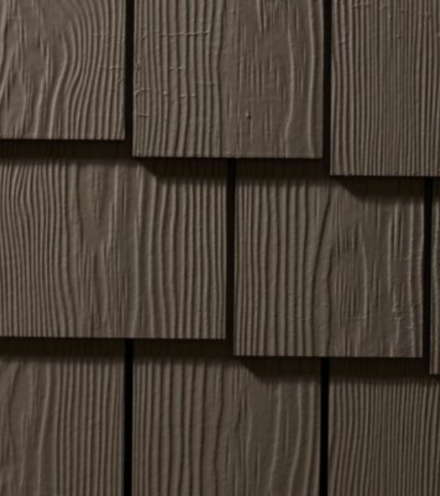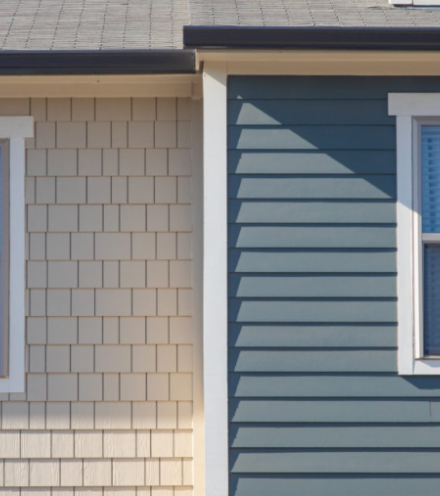Brick house or vinyl siding – what’s the right choice? While both of these siding materials are commonly used and are likely to create nice curb appeal for your home, there are some distinct differences you should be aware of when choosing brick siding vs. vinyl siding.
Aesthetic quality, cost, maintenance, and appearance are just some of the elements to consider. Depending on your budget, willingness to do maintenance, and style preferences, one of these materials is most likely going to be a better choice over the other. This article provides a practical guide to compare vinyl siding to brick so you can make the best decision for upgrading your home.
Vinyl Siding vs. Brick Siding: Get to Know the Difference
Understanding the difference between a brick home and vinyl siding comes down to how well you know these two classic materials. Most homeowners assume that the choice is as simple as deciding which style you like better. While appearance does play a significant role, there are many other distinctions between vinyl siding and brick that can have an even greater impact in the long run.

In many cases, these factors can affect the longevity of the exterior siding. In other words, how long will it last before it needs to be replaced? Product lifespan – along with the upkeep required to preserve the appearance of the siding – tends to be a significant factor in a homeowner’s choice of brick or vinyl siding.
Every siding product has pros and cons, and over-analyzing the options can also create confusion. It’s best to focus on three factors with the most impact: aesthetics, durability, and affordability.
Learn to Identify Different Types of Vinyl Siding and Brick Siding
Before breaking down those three factors – aesthetics, durability and affordability – in the comparison of vinyl siding and brick, it should be noted that there are many types of vinyl and brick on the market.
Traditional brick, which was originally built with multiple rows of full-sized bricks, offers a much more durable exterior than brick cladding or brick veneer, which are thinner layers of brick or brick-inspired styles that affix to the exterior. While modern brick cladding and brick veneer don’t provide the same level of strength, durability and insulation as traditional brick building exteriors, they are much more affordable and easier to install.
The main distinction in various types of vinyl siding is the thickness of the siding panel. Economy grade siding has a thickness of 0.038”, while premium grade siding has a thickness of 0.048”. Top of the line siding products extend the thickness to over +0.055” for each panel. Vinyl siding is not known for its durability, but selecting a higher grade can be one way to slightly boost the strength of the siding and hope for a longer product lifespan.
Aesthetics: Brick vs. Vinyl Siding

Siding plays a huge role in a home’s curb appeal, so aesthetics truly matter. Brick siding has a traditional look that comes in many colors, including red brick, tan brick, and natural beige brick. Brick is also easy to paint, which can help homeowners transform the appearance without installing new siding. While designs can be crafted to feature unique motifs in the brick layout, these styles aren’t so easy to change down the line.
Vinyl siding is available in a much broader selection when it comes to design. Homeowners can select from traditional lap, vertical board and batten, and other styles to craft the perfect exterior. Some vinyl siding even has a wood-look appearance with an attractive texture. Vinyl is fabricated in many different colors as well. However, one thing to consider with vinyl siding is that the color can fade with prolonged sun exposure, which can ultimately detract from the aesthetic value of the home.
Durability: Brick vs. Vinyl Siding
Brick has a significant advantage over vinyl when it comes to durability. Produced from plastic, vinyl is known to scrape and dent easily, which can be a concern for homeowners who live in an area with occasional heavy rain, hail, or high winds. Vinyl is also quite susceptible to temperature changes, and the freeze/thaw cycle can cause the siding to crack or buckle.
Brick has the advantage in this comparison, though brick is not entirely invulnerable to damage either. Moisture can cause cracks in the mortar of traditional brick, meaning homeowners may need to recaulk those areas to correct gaps.
Affordability: Brick vs. Vinyl Siding
There are pretty significant cost differences between vinyl siding and brick. The upfront costs of vinyl pale in comparison to brick, only costing about $2 per square foot.
Brick, on the other hand, can have a price tag of $4 - $10 per square foot depending on the thickness, with brick cladding and veneer costing much less than a traditional brick facade.
With that said, ongoing maintenance costs may make you change your mind about the affordability of vinyl siding. Since it’s prone to wear and tear, vinyl will likely require repair or replacement much sooner than brick.
The Better Alternative to Brick and Vinyl: Fiber Cement

Making the choice between brick veneer or vinyl siding can be tricky given the pros and cons of these two classic materials. Fiber cement siding is considered a superior option in some aspects compared to brick and vinyl siding, although the "better" choice can depend on various factors such as cost, aesthetics, maintenance, and climate. Here are a few reasons why fiber cement might be preferred over brick and vinyl siding:
Durability: Fiber cement is highly durable. It's resistant to many common issues that affect other siding materials, such as rot, termites, and fire. It's also known to withstand harsh weather conditions, including extreme temperatures and high winds.
Low Maintenance: Unlike wood, fiber cement doesn't require as much maintenance. It doesn't rot, warp, or become damaged by insects. While it might require occasional repainting, it generally holds paint well, extending the time between painting cycles.
Aesthetics: Fiber cement siding often mimics the appearance of wood or masonry, offering a wide range of textures and colors. It can give a house an attractive, natural look similar to that of wood or brick.
Cost: In some cases, fiber cement siding might be more cost-effective than brick, especially if you're looking for a material that provides good durability and a nice appearance at a lower price point. However, it might be more expensive than vinyl.
Contact Allura today for a look at fiber cement, a fantastic modern siding choice for both durability and aesthetics.




